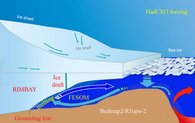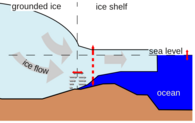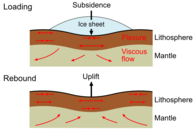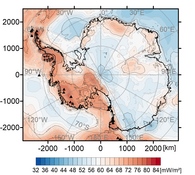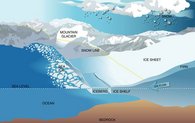Ice sheet - ocean dynamics
Ice shelves are in direct contact with the ocean water at their lower surface. Consequently, the temperature and the circulation of the ocean water in the ice shelf cavity determine the basal ice melt rates. They affect the shelf ice thickness and thus the position of the groundling line, which has a great impact on the dynamics of the adjacent grounded ice sheet, its mass balance and thus the global sea level. On the other hand, the shape of the ice shelf cavity, the position of the grounding line and the amount of melted fresh water have a crucial impact on the circulation of the ocean water underneath the ice shelf.
Publications:
Timmermann, R. and Goeller, S. (2017): Response to Filchner-Ronne Ice Shelf cavity warming in a coupled ocean-ice model. Part I: The ocean perspective, Ocean Science 13: 765-776
Thomas, M., Determann, J.; Grosfeld, K. Hellmer, H. and Goeller, S. (2015): Future sea-level rise due to projected ocean warming beneath the Filchner Ronne Ice Shelf: A coupled model study, Earth and Planetary Science Letters, 431: 217-224.
Bernales, J., Rogozhina, I., Thomas, M. (2017): Melting and freezing under Antarctic ice shelves from a combination of ice-sheet modelling and observations. - Journal of Glaciology, 63, 240, pp. 731-744. doi.1017/jog.2017.42 GFZPublic
Ice sheet - sea level
Ice sheets store large amounts of fresh water. Thus, every change of their mass balance has an impact on the global sea level. If the sea level is, e.g., rising, so far grounded ice comes afloat and the grounding line migrates further inland. In general, the position of the grounding line, which separates grounded and floating ice, is a key parameter for ice dynamics. Consequently, the sea level is considered a global coupling parameter. For example, the melting on the northern hemisphere can cause a global seal level rise and can thus influences the dynamics of the Antarctic Ice Sheet on the southern hemisphere. In addition, every variation of the ice mass causes local earth surface deformations and gravity changes, resulting in a local sea level change and thus an impact on the ice dynamics at the grounding line.
Publications:
Klemann, V., Heim, B., Bauch, H. A., Wetterich, S. and Opel, S. (2015) Sea-level evolution of the Laptev Sea and the East Siberian Sea since the last glacial maximum, arktos, 1 (1): 1-8
Konrad, H., Sasgen, I., Klemann, V., Thomas, M., Grosfeld, K., Martinex, Z. (2016): Sensitivity of Grounding-Line Dynamics to Viscoelastic Deformation of the Solid-Earth in an Idealized Scenario. Polarforschung, 85, 2, pp. 89-99. DOI: doi.org/10.2312/polfor.2016.005 GFZPublic
Current projects:
Ice sheet - lithosphere I
The glacial isostatic adjustment (GIA) describes how the Earth responds to the load of an ice sheet. The adaption of the Earth's body to the redistribution of ice and water since the last glacial maximum is still going on. It is observed and analyzed to estimate the extent and mass of former ice loads, to reconstruct the global sea level over one glacial cycle as well as determine the rheological properties of the Earth.
Ice sheet - lithosphere II
The geothermal heat flux between solid earth and ice sheet base influences the temperature and thus the viscosity of the ice. At higher temperatures the ice has a lower viscosity. As a consequence, the ice deforms easier under the influence of gravity which results in higher ice flow velocities. At lower temperatures, the ice has a higher viscosity which makes it stiffer. Thus, less internal deformation takes place resulting in lower ice flow velocities. If the geothermal heat flux flow reaches a certain threshold, basal melting occurs at the base of the ice sheet. This melt water lubricates the ice base and thus the ice sheet can slide on its substrate. Underneath the Antarctic Ice Sheet, basal water forms thin water layers, rivers and large lakes and flows over huge distances. The existence of water at the ice sheet base increases the ice velocity as well, since its the sum of internal deformation and basal sliding.
Publications:
Goeller, S., Steinhage, D., Thomas, M. and Grosfeld, K. (2016): Assessing the subglacial lake coverage of Antarctica, Annals of Glaciology, 57(72): 109 - 117
Rogozhina, I., Petrunin, A. G., Vaughan, A. P. M., Steinberger, B., Johnson, J. V., Kaban, M. K., Calov, R., Rickers, F. Thomas, M., Koulakov, I. (2016): Melting at the base of the Greenland Ice Sheet explained by Iceland hotspot history. - Nature Geoscience, 9, pp. 366-369. DOI: doi.org/10.1038/ngeo2689 GFZPublic
Ice sheet - atmosphere
The albedo of a surface influences the radiation balance and thus the temperature at the surface. Clean and white snow (e.g., Antarctic Ice Sheet) has a high albedo, reflecting almost the entire incidental radiation. Black ice (e.g., Alpine glacier during summer) and dust covered ice (e.g., Greenland Ice Sheet at its margins) absorb much more of the incidental radiation, leading to a rise of temperature at the surface and as a possible consequence to surface melting. The temperature at the ice surface has an impact on the temperature of deeper ice layers as well. It affects the viscosity of the ice which determines the grade of internal deformation and thus the ice flow velocity. Moisture fluxes at the ice surface have an impact on the dynamics of the atmosphere. In turn, the dynamics of the atmosphere with its precipitation have a crucial impact on the mass balance of the ice sheet.


